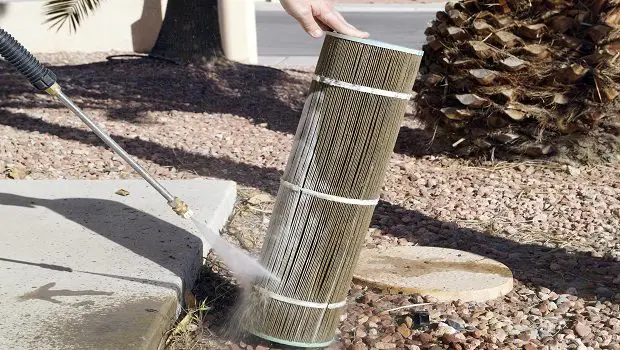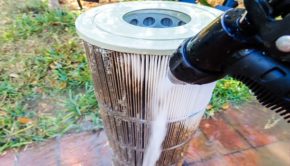Maintaining & Cleaning Your Pool Filter: When to Rinse or Replace Filters, Cartridges & Sand
DISCLOSURE: As an Amazon Associate, I earn from qualifying purchases.
Some pool owners clean their filters on a regular schedule, such as weekly or every three months. Others watch the pressure gauge and clean the filter when the needle rises to a certain PSI amount.
Either way is okay. The most important thing is that you clean your pool filter before it gets clogged and starts wearing out your pool equipment. It’s also essential that you clean your pool filter the right way, depending on the type of filter you have.
In this how-to guide, we give you the best advice from pool experts regarding cleaning, rinsing, and replacing your pool filter.
But first, a quick primer on the three types of filters used in pools. Once you determine which one is in your pool, it’s easy to keep it clean.
3 Types of Pool Filters
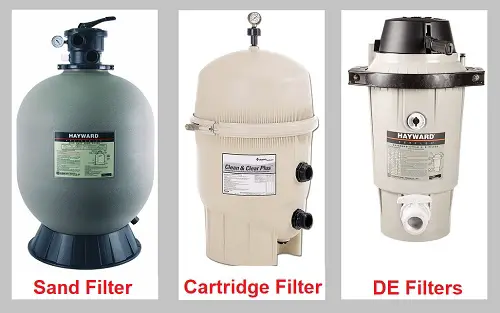
Cartridge Filters
Cartridge filters pass water through a fabric type material that traps debris and particles as small as 10 microns. They remove finer debris compared to standard sand filters.
One big advantage of cartridge filters is that they do not require backwashing, which saves water. You only need to clean the filter after around three months and replace it after a few years.
Sand Filters
Sand filters capture larger debris (down to 20-40 microns) compared to cartridge filters. They use #20 silica sand to filter particles and debris from water passing through the sand.
Sand filters need to be back washed often to keep them clog-free. After some years, you need to replace the sand.
Nowadays, companies sell a variety of sand alternatives, such as FilterGlass and ZeoSand. These sand alternatives filter finer particles (under 5 micron) than standard silica sand. Also, you need less of these materials (50% less in the case of ZeoSand) to keep your pool clean.
DE Filters
The filter media in DE pool filters is diatomaceous earth. It can remove particles as small as 3-5 microns.
Similar to a sand filter, a DE filter needs to be cleaned often. You’ll also need to top up the DE media since some of it is rinsed away together with the debris during backwashing.
How to Clean Your Pool Filter?
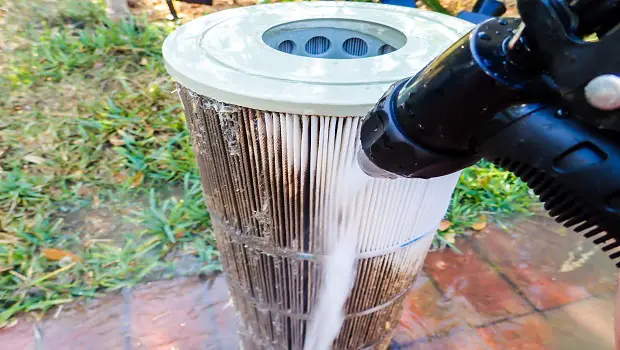
Cartridge Filters
- Turn off the pool pump. This is a good opportunity to check whether your pressure gauge is working properly. With the pump off, it should read zero. If it doesn’t, you need to repair or replace it.
- Slowly open the air relief valve on the filter to get rid of excess air. Now you can open the filter and carefully remove the cartridges.
- Check the condition of the cartridges. If they appear worn out or mushy, it’s better to get new ones instead of washing them.
- If they are in good condition, just dirty, choose from one of three washing methods described below.
Water-only cleaning: In most cases, you only need a garden hose to clean the cartridges. Attach a spray nozzle to the hose and direct the spray towards the wrinkles at a 45-degree angle. Do not use a pressure washer as it’ll damage the cartridges.
To save time and target the pleats more effectively, consider getting a dedicated filter cleaning tool like the Filter Flosser.
Using a spray cleaner: If your cartridges appear dirtier than usual, a spray cleaner will eliminate the stubborn dirt. Simply spray the cleaner along the cartridge pleats, let it soak for the recommended number of minutes then rinse with a garden hose.
24-hour soak: For really dirty filter cartridges, a 24-hour soak is the best option. Mix a filter cleaner with water in a large bucket. Submerge the cartridges completely in the water, soak for 24 hours, and then rinse them off.
After cleaning the cartridges, re-assemble the filter, open any valves you had closed and turn on the pool pump.
Take note of the PSI reading on the pressure gauge when the cartridges are newly washed. If working pressure reaches 8-10 PSI above the normal pressure or 25% of the normal reading, it’s time to wash the cartridges.
Regardless of the pressure reading, you should wash the cartridge filter every 3-6 months. And once a year, do a 24-hour soak for deep cleaning.
DE Filter
Cleaning your pool’s DE filter is a 3-step process: backwashing, rinsing the grids and adding more DE.
- With the pool pump turned off, turn the filter valve to the backwash position. Turn on the pump to allow pool water to flow through the filter.
- You should see murky water coming out of the drain port. Once the draining water turns clear, turn off the pump and return the filter valve to the normal position.
- The next step is to open the filter and rinse out the grids. First, drain the tank by turning off the pump, opening the air relief valve, and opening the drain plug.
- Remove the metal clamp or whichever assembly is securing the filter tank. Check your filter manual for instructions on how to open your particular filter tank.
- Remove the filter grids and rinse them with a garden hose. Also, rinse the empty tank.
- Put back the grids and secure the tank. Remember to close the drain plug and air-relief vent.
- Turn the pump on and add the recommended amount of new DE to the pool skimmer. For most DE filters, you need to replenish the filter with 80% of the original amount of DE. But check the manual to confirm.
Watch your DE filter’s pressure gauge to determine when to clean it. If it rises 8-10 PSI above the normal reading, it needs a clean. Regardless of the pressure reading, make sure you clean the filter once a month.
Note: Some DE filters have a bump lever that you operate to release oils and debris from the filter grid. You bump the filter twice (instead of backwashing it). However, you still need to open the tank, remove the grids, and give everything a thorough hosing.Â
Sand Filter
Unlike a DE filter, all the sand remains in the sand filter when you backwash. So there is no need to replenish the sand.
- Turn the pump off and switch the filter to the backwash position.
- Before you turn the pump back on, make sure you position the drain hose where you want the dirty water to go. You can then turn the pump back on and let the filter backwash.
- Most sand filters have a clear sight glass where you can monitor how clean the water is. You can also check the water coming out of the hose. Once the water appears clear, the filter is clean, and you can turn the pump off.
- Turn the filter valve to the rinse position and turn the pump back on. Let the pump run for two minutes, then turn it off again.
- Turn off the pump and return the filter valve to the normal filter position. Turn the pump back on and check whether the pressure gauge has returned to a normal reading.
Like other filters, a rise of 8-10 PSI on the pressure gauge indicates that there’s too much debris trapped in the sand filter.
But even if the number on the gauge doesn’t rise that high, you should still backwash the sand filter weekly, especially if your pool gets a lot of debris. For a lightly used pool that doesn’t get very dirty, you can backwash every two weeks.
When to Replace the Pool Filter
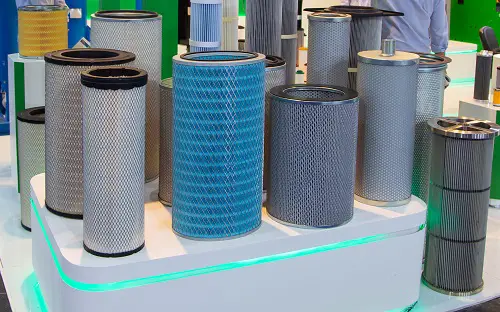
Your filter user manual will contain instructions on when to replace the filter media. Here are the general recommendations for different types of filters.
Cartridge filter: After 3-5 years.
Sand filter: After 5-7 years.
DE filter grids: After 7-10 years.
A good way to tell that you need to get a new filter is when you start cleaning the filter more frequently than usual.
If the pressure rises soon after you’ve cleaned the filter, it means it’s not working properly. You can also look at the filters for DE grids and cartridge filters to see how worn out they appear.
Another good way to check your pool filter’s condition and performance are to check if your pool is clean. If, after vacuuming, cleaning the filter, and adding chemicals to the pool, the water is still cloudy, slimy, or smelly, the pool filter is likely not working, and you need to replace it.
Tip: Don’t forget to regularly check the condition of other parts of the filter, such as the O-rings. If parts appear worn out, replace them as soon as possible. A degraded O-ring can compromise the function of the entire filter.
How to Increase the Lifespan of Your Pool Filter?
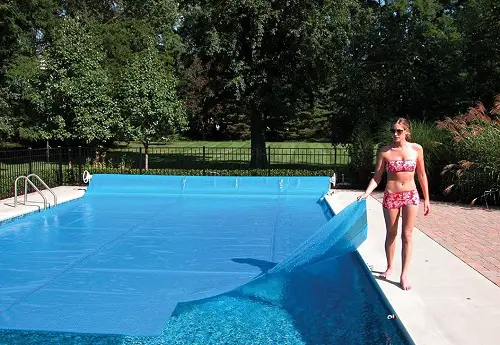
An easy way to make your pool filter last longer and reduce how often you have to clean it is by reducing the amount of debris it needs to handle.
That means ditching manual brushing and vacuuming for an automatic pool cleaner.
A robotic pool cleaner is the best and often provides the most thorough cleaning. A pressure cleaner is a slightly cheaper option. We like it because it comes with a debris bag/basket instead of redirecting debris towards the pool filter.
A suction cleaner doesn’t increase your pool filter’s lifespan since the filter still ends up doing all the cleaning work. The exception is if you use an in-line leaf canister. It’ll trap large debris before they reach the filter.
In addition to an automatic pool cleaner, we highly recommend a solar cover. It’ll not only prevent water and heat loss, but it’ll also keep debris from falling into the water.

